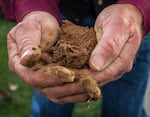
Oklahoma Conservation Commission Soil Scientist Greg Scott holds healthy soil that absorbed two inches of simulated rainfall, during the U.S. Department of Agriculture (USDA) Natural Resources Conservation Service soil health demonstration event “The Bundled Benefits of Soil Health” on Thursday, September 18, 2014 in the People’s Garden, at the USDA headquarters, in Washington, D.C.
Courtesy of Lance Cheung/USDA
When we think about the ways our climate is changing, we often look to the seas or the skies or the land: things like warming waters, hurricanes and wildfires. But scientists are now looking underground, turning their focus to soil. That’s because after the ocean, soil is the second-largest thing on earth that can capture and store carbon. In fact, there’s about six times more carbon stored in the soil than there is in the plants that grow on the soil. And a new study published this month finds that moisture plays a key role in soil’s carbon storage.
Jeff Hatton is a Department Head and Professor of Forest Soils in Oregon State University’s College of Forestry and co-authored the study. He joined “All Things Considered” host Crystal Ligori to explain more about the findings.
Crystal Ligori: Can we start just by talking a little bit about soil and what its relationship to carbon is?
Jeff Hatton: Yeah, so one thing I like to say about soil is that we’re only temporarily not soil. In particular, our carbon in our bodies and our plants and our ecosystems that are living will eventually make its way back into the soil. And the ultimate source of all carbon in the soil is plants and then of course that gets processed by animals and microbes. Soils make up most of the carbon in our terrestrial ecosystems. So trees and plants and animals seem like the obvious pockets of carbon in our ecosystem. [But] soils can be roughly six times larger in terms of the storage pool of carbon in our terrestrial ecosystem.
Ligori: So what did this new research that you were involved with find?
Hatton: So our research is part of a new perspective on soil and organic matter. The main way that carbon is stabilized in soil is on the surfaces of minerals. You can think of this as basically like paint on your wall. Organic matter is chemically bonded to the surfaces of minerals. And so that’s what our study looked at. We looked at the mineral associated organic matter and soils and this carbon represents about 80% or so of all the carbon in our soils. And so what we found was this mineral associated organic matter, it’s the slowest cycling organic matter in our soils, meaning that it’s there for a longer time. And so we use radiocarbon in C14 to basically date or age the organic matter in the soils. And so what that does is it helps gauge how fast that carbon is cycling in the soil. And so what we found was that the amount of carbon in the soil was related to how fast it cycles, but only in wet environments. So the more carbon that’s in the soil in a wet environment, the faster it cycles. Whereas in a dry ecosystem, there was no relationship.
Ligori: So if we’re talking about moisture in the soil, how do major weather events, things like an atmospheric river or even that heavy snowfall we just had, impact soil moisture and its ability to capture that carbon?
Hatton: Well, that’s a tough question to answer because these stochastic events like, you know, heavy rainfalls or longer winters are shorter winters and the time frame that soil exists is a pretty, pretty short lived event. As we have more droughts, as temperature regime changes or for precipitation regime changes, those could have implications on the stability of the organic matter in the soil, you know, in wet environments, things that speed up the cycling of organic matter. So temperature, an increase in soil temperature or a changing climate that results in higher temperatures could result in lower carbon in those ecosystems. Whereas in a dry environment changes in temperature might not result in much change unless there’s a concurrent change in the moisture regime of that site.
Ligori: Do you think we should change how researchers are approaching how we study soil carbon?
Hatton: Yeah, I think so. I mean, it’s not to say that climate modelers or scientists that are studying climate and the impacts of climate on ecosystem, you know, didn’t consider temperature and moisture, but I think they were mostly focused on moisture as something that might change the plant type and ecosystem different species abundance and things like that. I think our study shows that we also need to consider moisture on the below ground carbon pools as well, in particular in these dry environments. So we need to consider where that ecosystem was and how the moisture is changing before we can predict how it might respond to changes in temperature or moisture or that kind of thing.